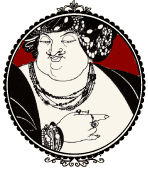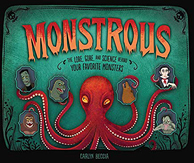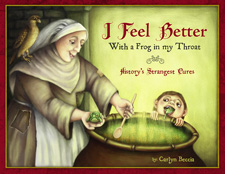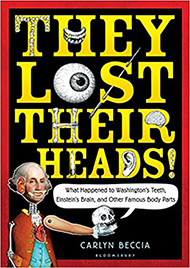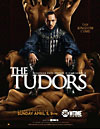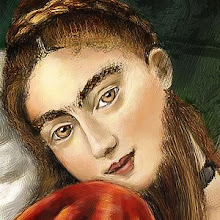
I know there is something undeniably creepy about a grown women playing with dolls. I don’t care. I love my new miniature dolls from Uneekdolldesign. Uneekdolldesign hand crafts royal queens and kings from several periods along with some of my favorite literary heroes like the Bronte Sisters. What could be better for writers block than the 3 sisters staring you down as you click clack away on your keyboard? Come on…you know you want a tiny Eliza Doolittle perched on your desk.
What’s Your Favorite Tiny Historical Figure?
It was a tough choice, but I had to go with cousins Mary Queen of Scots and Elizabeth I of England. I have already written plenty about these two dueling dames.
 The Come Back Queen
The Come Back QueenMary Queen of Scots was Henry VII’s great-granddaughter and Elizabeth was Henry VII’s granddaughter. Both queens had claims to the English throne, but if you were on the side of the church, Mary’s claim was much stronger. Elizabeth’s succession had gone through an especially shaky period after the execution of her mom, Anne Boleyn (that’s the one with the supposed sixth finger) Thereafter, Henry VIII (that’s the really fat one) made Elizabeth a bastard at the tender age of 2. In typical Cinderella like fashion, Elizabeth spent her younger years with her nose in a book trying not to anger her father or her religious half-sister, Mary I (that’s the other Mary…the one with a drink named after her). But good ole Hank had a soft side for that feisty red-head and restored Elizabeth to her place in the succession before his death. Elizabeth was crowned queen of England in 1559 and they all lived happily ever after. The End.
No. Not quite…Stay with me the drama is just heating up.
 The Big Question: Who Gets to Wear the Pearls?
The Big Question: Who Gets to Wear the Pearls?So Pope Pius V (that’s the man with the funny cap) basically says…. wait just a holy minute here! Elizabeth is a heretic, a bastard, a no-good crown stealer and called her a bunch of other nasty things. Then he finished it off with one of those scary Pabal Bull thingies that meant you were going straight to hell. Unnerved, Elizabeth dodged the death threats and carried on with her queenly duties. But always looming in the background…we have a problem. Who is the rightful queen of England? Mary or Elizabeth?
Like watching a muddy female wrestling match, each queen showed her claws. Here’s a blow by blow of some of their more raucous battles.
 Round 1: Some Bad Legal Advice
Round 1: Some Bad Legal AdviceMary’s showed her perfidious side when she refused to ratify the Treaty of Edinburg. (that’s the treaty that denounced Mary’s claim to the English throne). At the time, Mary was already queen of Scotland AND France. Adding England to her resume was a bit greedy. All she had to do was sign the darn paper, stand up to her power-hungy uncles and end it. But, Nooooo. She had to go and antagonize her cousin.
 And in this corner…
And in this corner…After King Francis II died (that was Mary’s sickly, French husband), Mary decided to return to Scotland. Traveling was a dangerous business in the 16th century made harder by the fact that Elizabeth refused Mary safe-conduct through England (she later granted it, but by then it was too late). Not granting safe conduct not only threw off Mary’s travel plans, it was also a serious royal snub and one Mary would never forget.
 Round 2: Let’s be Friends
Round 2: Let’s be FriendsIn an effort to make nice, Mary offered to sign the Treaty of Edinburg on the condition that Elizabeth name her as her successor. Elizabeth was suspicious, but offered to meet with Mary in hopes of coming to an agreement. The meeting was arranged for the fall of 1562. Mary was so excited to meet her cousin that, “she wished one of them was a man, so that their kingdoms could be united by marital alliance.”1 Aaaaaah Ain’t that sweet? This reply may sound like a serious girl-crush to our modern ears, but marriages were not based on love matches. Mary was most likely genuine in her hopes and very nervous about meeting her “good sister and cousin.”
 Round 3: A Knife in a Protestant Back
Round 3: A Knife in a Protestant BackBut then the especially distasteful St. Bartholomew’s Massacre messed everything up. Back in France, Catholic and Protestant factions were ripping each other to shreds and throwing babies out the window if they were the wrong religion. Mary should have stayed out of the whole unpleasant business. Instead, she offered aid to her Catholic relatives. The Protestant Queen Elizabeth was forced to cancel the meeting. Mary went to her sick bed depressed and miserable.
 Round 4: Some Bad Love Advice
Round 4: Some Bad Love AdviceThings turned icy between the two queens for some time. The threat of Mary still loomed over Elizabeth’s throne, but the threat of a single Mary was even scarier. Mary could marry and form an alliance with any one of the Catholic royal houses of Spain, Austria or France thereby further endangering England. Mary could certainly wed, but it had to be someone of Elizabeth’s choosing. In what seems like astounding arrogance, Elizabeth sent Mary a list of 3 possible suitors for her hand in marriage; The Earl of Leicester (that was Elizabeth’s boy toy “robbin”), The Duke of Norfolk, and Lord Darnley. If Mary wed one of these three available bachelors then Elizabeth promised to name Mary as her successor. Decisions. Decisions. What will our passionate heroine do?
 Round 5: Look What Happens when you play Matchmaker
Round 5: Look What Happens when you play MatchmakerMary chose Lord Darnley. He certainly looked good on paper. He was handsome and rich and also had a claim to the English throne. He also was a syphilitic drunk who liked to beat the servants in his spare time. No one really liked Darnely, especially the Scottish lords. They had their skirts all bunched up (kilts had not been invented yet) until they decided enough already with this blockhead. Darnley soon ended up strangled to death outside the gardens of Kirk o' Field and Mary was accused of being involved in his untimely death.
The scandal might have blown over if she had not married one of the suspects in her husband’s murder, Lord Bothwell. The hanky panky between Mary and Bothwell was rumored to have gone on before Darnley's death. Mary also happened to look very pregnant shortly after her marriage to Bothwell probably due to the fact that she was carrying twins. Now you can do the math…we have adultery, some murder, a very pregnant looking Mary. It doesn’t look good to the kids of Scotland. Mary was eventually forced to flee Scotland and she went straight into the spider’s nest of England.
 Round 6: A Visit from an Unwanted Relative
Round 6: A Visit from an Unwanted RelativeNow what was Elizabeth to do? Mary was on English soil looking for a safe place to stay. Her catholic presence was threatening enough when she was in Scotland, but it was doubly problematic on the shores of England. Elizabeth decided to lock Mary up until she could figure out what to do with her. Unfortunately, it took about 19 years for Elizabeth to come to a not-so pretty solution.
Round 7: Plots and Intrigue
While Mary was imprisoned she was left with nothing to do but embroider unicorn tapestries, get fat, pray, write a few whiny letters and most importantly…. plot her cousin’s downfall. You can read more about the foolish Babington Plot and Mary’s attempts to take down Elizabeth in the book. (Or stay tuned for future blogs because I may write an even juicier part 2 to this drama covering the Ridolfi and Babington Plot.)
 Round 8: The Coup d’Etat
Round 8: The Coup d’EtatThis fairy tale has a sad ending….sadder than the death of my favorite golden girl. Elizabeth was forced to put a finish to Mary’s intrigues on the scaffold. In the end, Elizabeth was left wearing Mary’s pearls (literally) around her neck and Mary was left without a head on her neck.
Knock-out from Elizabeth.
 But Wait…What’s Wrong with this Picture?
But Wait…What’s Wrong with this Picture?
You could answer: Well, it is sort of disturbing that you are taking pictures of dolls. Yes True. But the real answer is that I should not even display these two dolls next to each other because historians (that’s the people who are really smart about such things) claim that Elizabeth and Mary NEVER met.
Now, maybe it’s because I have seen too many drunken girl fights in my rowdy college days, but I just don’t buy it. Elizabeth had Mary locked up for nearly 19 years, but never bothered to hop in her litter and take a little trip over to see her cousin? She was not just a tiny bit curious to see the famed sorceress who had bewitched countless men? Pleeeeeeease. Elizabeth loved a good intrigue as much as any pot-stirring courtier.
Jealousy Leads to Curiosity...
Elizabeth exposed her catty curiosity toward her elusive cousin on several occasions. When she asked Scottish emissary, Sir James Melville to give a detailed report on Mary, Elizabeth’s questions didn’t exactly focus on the political climate of Scotland. Instead, she asked frivolous questions like - so what does the wench look like? When her advisor described Mary’s statuesque height, she vainly replied “then she is too high; for I myself am neither too high nor too low!” 2 And when one foreign diplomat reported on Mary’s charms, Elizabeth rebuked “she herself was superior to the Queen of Scotland.3” But most telling of all was Elizabeth’s most famous lament at the birth of Mary’s son James I when she peevishly complained, “The Queen of Scots is mother of a fair son and I am but barren stock4” We must look somewhat skeptically at these quotes because many are second-hand accounts. Still, Elizabeth does appear to compare herself to her cousin on several occasions. Yet, she was never curious to see how their heights measured up in person? Come now.
Pen Pals and Strangers
And let’s not forget the letters. Elizabeth and Mary wrote to each other many, many times. Mary sent Elizabeth her portrait. Elizabeth sent Mary a beautiful ring in return which Mary wore constantly. After countless letters, gifts, and failed attempts to meet, how do you pass up the opportunity to pay a visit to your closest adult relation when she happens to be locked up in one of your castles? Elizabeth’s advisors were certainly against the two queens meeting, but could they have really prevented a meeting?
So what do you think? Are you an Elizabeth or a Mary supporter? Do you believe they never met?
Sources:
Weir, Alison. Elizabeth the Queen. London: Jonathan Cape, 1998.
Klarwill, Victor von. Queen Elizabeth and Some Foreigners. London: John Lane, 1928.
Fraser
Fraser, Antonia. Mary Queen of Scots, London: Phoenix Press, 1969.
Dunn, Jane. Elizabeth and Mary: Cousins, Rivals, Queens. New York, NY: Randon House, 2004.
Somerset, Anne. Elizabeth I. New York, NY: Macmillan, 1992.
Jenkins, Elizabeth. Elizabeth the Great. New York, NY: Coward-McCann, 1958.
Brysson Morrison, Nancy. Mary, Queen of Scots. New York, NY: Vanguard Press 1960.
Notes:
1. Weir, p. 129
2 .Somerset, p. 166
3. Klarwill, p. 215
4, Brysson Morrison, p. 147
 But Wait…What’s Wrong with this Picture?
But Wait…What’s Wrong with this Picture?You could answer: Well, it is sort of disturbing that you are taking pictures of dolls. Yes True. But the real answer is that I should not even display these two dolls next to each other because historians (that’s the people who are really smart about such things) claim that Elizabeth and Mary NEVER met.
Now, maybe it’s because I have seen too many drunken girl fights in my rowdy college days, but I just don’t buy it. Elizabeth had Mary locked up for nearly 19 years, but never bothered to hop in her litter and take a little trip over to see her cousin? She was not just a tiny bit curious to see the famed sorceress who had bewitched countless men? Pleeeeeeease. Elizabeth loved a good intrigue as much as any pot-stirring courtier.
Jealousy Leads to Curiosity...
Elizabeth exposed her catty curiosity toward her elusive cousin on several occasions. When she asked Scottish emissary, Sir James Melville to give a detailed report on Mary, Elizabeth’s questions didn’t exactly focus on the political climate of Scotland. Instead, she asked frivolous questions like - so what does the wench look like? When her advisor described Mary’s statuesque height, she vainly replied “then she is too high; for I myself am neither too high nor too low!” 2 And when one foreign diplomat reported on Mary’s charms, Elizabeth rebuked “she herself was superior to the Queen of Scotland.3” But most telling of all was Elizabeth’s most famous lament at the birth of Mary’s son James I when she peevishly complained, “The Queen of Scots is mother of a fair son and I am but barren stock4” We must look somewhat skeptically at these quotes because many are second-hand accounts. Still, Elizabeth does appear to compare herself to her cousin on several occasions. Yet, she was never curious to see how their heights measured up in person? Come now.
Pen Pals and Strangers
And let’s not forget the letters. Elizabeth and Mary wrote to each other many, many times. Mary sent Elizabeth her portrait. Elizabeth sent Mary a beautiful ring in return which Mary wore constantly. After countless letters, gifts, and failed attempts to meet, how do you pass up the opportunity to pay a visit to your closest adult relation when she happens to be locked up in one of your castles? Elizabeth’s advisors were certainly against the two queens meeting, but could they have really prevented a meeting?
So what do you think? Are you an Elizabeth or a Mary supporter? Do you believe they never met?
Sources:
Weir, Alison. Elizabeth the Queen. London: Jonathan Cape, 1998.
Klarwill, Victor von. Queen Elizabeth and Some Foreigners. London: John Lane, 1928.
Fraser
Fraser, Antonia. Mary Queen of Scots, London: Phoenix Press, 1969.
Dunn, Jane. Elizabeth and Mary: Cousins, Rivals, Queens. New York, NY: Randon House, 2004.
Somerset, Anne. Elizabeth I. New York, NY: Macmillan, 1992.
Jenkins, Elizabeth. Elizabeth the Great. New York, NY: Coward-McCann, 1958.
Brysson Morrison, Nancy. Mary, Queen of Scots. New York, NY: Vanguard Press 1960.
Notes:
1. Weir, p. 129
2 .Somerset, p. 166
3. Klarwill, p. 215
4, Brysson Morrison, p. 147

